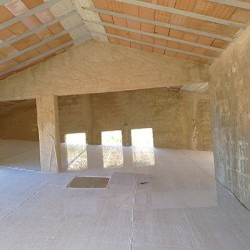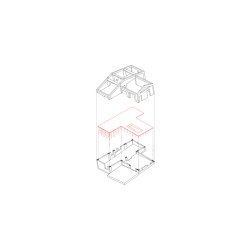Brandlhuber+ . photos: © Erica Overmeer
Nested in a Castellamare valley, Casa Storta sits on a small hill facing towards the sea, surrounded on three sides by rocky cliffs. The site, enveloped in the landscape, is now protected by regulations that prohibit further building. After heavy rain, the house, which was never completely finished, tilted more than two meters towards one corner. Unwilling to destroy it, the owners left the house in this state of ruin. The house was originally built using a concrete structure and local tuff stone, which preserved the general form and protected the interior from the elements. Thanks to this building technique, the structural integrity and overall quality of the house survived, simply left on an angle.
This produced the strange condition of a disorienting yet inhabitable house. Stuck in a state of disrepair, the house was unattractive to potential buyers who knew that if they purchased the plot, they would be unable to build anything new. After it was purchased in 2016, the question became how to use the slope in the future. To better understand the effect of living in a sloping house, a new, flat surface of translucent fabric was inserted. This artificial level became the departure point for imagining a house with two kinds of spaces: one that would be parallel with the visible horizon, and the original floor, which would not. The existing window openings further this sense of disorientation, offering an opportunity for the surrounding landscape to visually enter the interior. The decision to keep the original slanted surface is a reference to Claude Parent’s idea for the ‘function oblique’. In his proposal, which serves as a model for a new kind of living, all surfaces are sloped in order to engage the human body, turning the house into a single undulating landscape of continuous spaces. All of the house’s furniture and functions should be part of unified surface. Following this approach in Casa Storta, functions, such as the toilet, bathtub, kitchen, and seating are indented into the floor slab, creating a single landscape for living.
_
Casa Storta
Scopello, 2017-, Brandlhuber+ Michalski&Wagner; Elena Catalano, Olaf Grawert, Roberta Jurcic, Noël Picco, Meghan Rolvien, Daniel Seeleitner, Kaat Volckaert, Anna Wisborg






